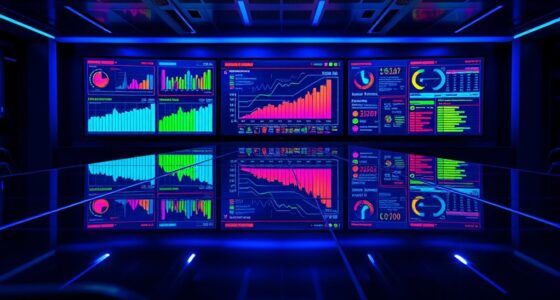Low-code and no-code tools make creating data visualizations quick and simple, even if you don’t have much programming experience. They offer intuitive interfaces that help you turn complex data into clear, impactful visuals easily. These platforms save you time, streamline workflows, and enable faster data-driven decisions. However, choosing the right tool can be tricky due to automation and UI challenges. Keep exploring to discover how to select the best options for your needs.
Key Takeaways
- Low-code/no-code tools simplify data visualization creation without extensive programming skills, enabling faster insights.
- They often feature user-friendly interfaces that reduce clutter and guide users through visualization processes.
- Automation capabilities vary, so selecting platforms with robust automation improves data update efficiency and reduces troubleshooting.
- Choosing tools with intuitive design enhances workflow speed and minimizes errors during visualization development.
- Prioritizing platforms that balance advanced features with ease of use optimizes data analysis and presentation efforts.

Are you looking for an easier way to turn complex data into clear, compelling visuals? If so, low-code and no-code tools might be just what you need. These platforms enable you to create insightful visualizations without extensive programming knowledge, saving you time and effort. But, as with any technology, they come with their own set of challenges, especially around automation and user interface design. Understanding these hurdles can help you choose and implement the right tools effectively.
Automation challenges often surface when trying to streamline data workflows within low-code and no-code platforms. While these tools are designed to simplify processes, integrating them with existing data sources or automating repetitive tasks can be tricky. Sometimes, the platforms lack advanced automation features, forcing you to rely on workarounds that may not be reliable or scalable. Additionally, ensuring that data updates automatically and accurately reflects in your visualizations requires careful setup, which can be confusing if the platform’s automation capabilities are limited or poorly documented. This means you might spend more time troubleshooting automation issues than actually analyzing your data, defeating the purpose of using these tools in the first place.
Automation hurdles can slow down data workflows and require troubleshooting, limiting the efficiency of low-code and no-code visualization tools.
User interface design is another critical aspect that influences your experience with low-code and no-code data visualization tools. An intuitive UI can make it easy for you to drag, drop, and customize visual elements without a steep learning curve. Conversely, a cluttered or unintuitive interface can slow you down and cause frustration. Many platforms struggle to balance simplicity with advanced features, often overwhelming new users with too many options or hiding essential controls behind layers of menus. When user interface design isn’t thoughtfully implemented, it can hinder your ability to quickly generate clear visuals, leading to a less efficient workflow. You want a platform that guides you smoothly through the process, with logical layouts and helpful prompts.
Ultimately, selecting a low-code or no-code tool that addresses these challenges is key. Look for platforms that prioritize user-friendly design and robust automation capabilities. This way, you can focus on your insights rather than wrestling with the tool itself. Remember, the goal is to transform complex data into visuals that tell a story, not to get bogged down by technical hurdles. With the right platform, you’ll find that creating compelling data visualizations becomes faster, easier, and more intuitive—empowering you to make data-driven decisions confidently. Understanding automation limitations can help you better navigate these platforms and optimize your data workflows.
Frequently Asked Questions
How Do Low-Code Tools Ensure Data Security and Privacy?
You can trust low-code tools to keep your data secure by implementing data encryption, which protects sensitive information during storage and transmission. They also use access controls, allowing you to set permissions and restrict who can view or modify data. These security measures guarantee your privacy is maintained, giving you peace of mind while creating visualizations. Always review the platform’s security features to ensure they meet your organization’s privacy standards.
Can Non-Technical Users Customize Complex Visualizations Easily?
Yes, non-technical users can customize complex visualizations easily with these tools. The user interface is designed for simplicity and intuitive navigation, allowing you to modify charts, filters, and layouts without coding. This customization flexibility lets you tailor visualizations to your specific needs, making data insights clearer and more impactful. You don’t need technical expertise—just explore the options, and you’ll create sophisticated visuals effortlessly.
What Are the Limitations of No-Code Data Visualization Platforms?
You may find no-code data visualization platforms feel like trying to paint a masterpiece with limited colors. Their simplicity often hits a wall with scalability challenges, making it hard to handle large datasets or complex insights. Customization restrictions can leave your visuals feeling generic, unable to capture your unique story. While easy to use, these tools sometimes constrain your creativity, requiring advanced solutions for more sophisticated, scalable visualizations.
How Do These Tools Integrate With Existing Data Systems?
You can integrate these tools with your existing data systems through API integration, enabling seamless data synchronization. This allows your visualizations to stay updated in real-time as data changes, without manual effort. Most platforms offer user-friendly connectors or custom API options, making it straightforward to link with databases, cloud services, or other data sources. This integration guarantees your visual insights are accurate and current, improving decision-making efficiency.
What Are the Costs Associated With Popular Low-Code Visualization Tools?
You’ll find that popular low-code visualization tools typically charge between $10 and $50 per user license monthly, depending on features. A recent survey shows that 65% of businesses prefer subscription-based pricing models, which offer scalability and flexibility. Costs vary based on user licensing, with some providers offering tiered plans for different team sizes. Consider these factors to budget effectively and choose a tool that fits your organization’s needs.
Conclusion
By using low-code and no-code data visualization tools, you can quickly turn complex data into clear insights without extensive technical skills. Did you know that 80% of non-technical users report improved decision-making with these tools? Embracing them means faster, more accessible data storytelling. So, why wait? Start exploring these options today and unleash the power of your data—your smarter, data-driven future is just a few clicks away.










